Some would argue that the 1970s were a part of the golden age of Indiana high school basketball. The single class basketball system still ruled the day and gyms were often packed for big contests where rivalries were involved. There had yet to be a three point line established, an innovation that so changed the game, and every town, large or small, had its own newspaper with thick sports pages. It is this setting that frames the following story.
While working on a book about Larry Bird’s high school basketball years, I came across another important tale that certainly deserves the light of day. It is sad but sometimes true that an Indiana high school basketball player will have an exceptional career, only to see their accomplishments forgotten because of unusual circumstances. A case in point is Springs Valley High School star Steve Land, who played three years of varsity basketball in the early 1970s. As fate would have it, Land’s many records and great play came just before Larry Bird’s unbelievable breakout season in 1973-1974.
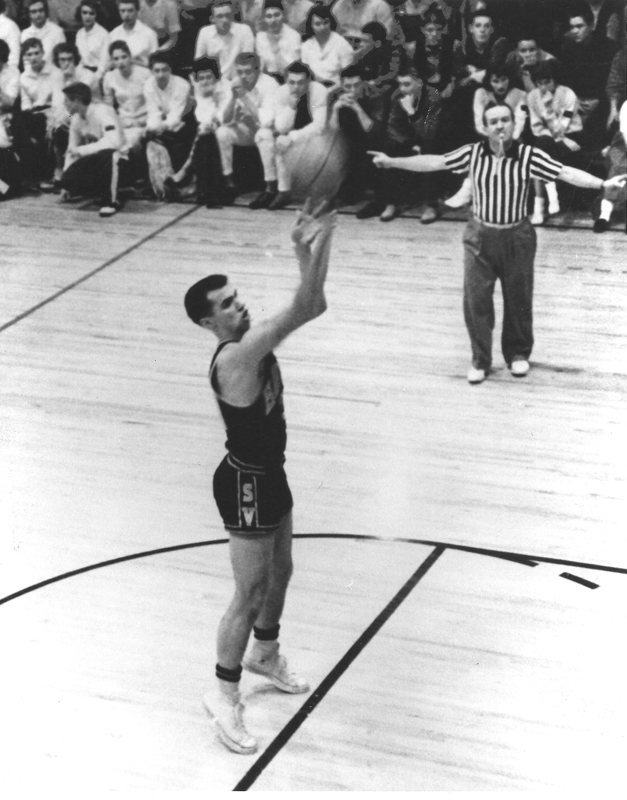
Steve began playing varsity for Coach Jim Jones during his sophomore year, 1970-1971, the season after the Blackhawks had been emotionally devastated, coming into the 1970 Paoli sectional with a great record and as the favored team, only to lose to county arch rival Paoli in a major upset. The 1970-1971 group was given little chance by sports reporters, or many of its fans, to do well in the regular season or in sectional play. But led by senior Mark Bird, Larry Bird’s older brother, the Blachawks caught fire in their last several games, coming into the Paoli sectional at 12-8 and capturing the title.
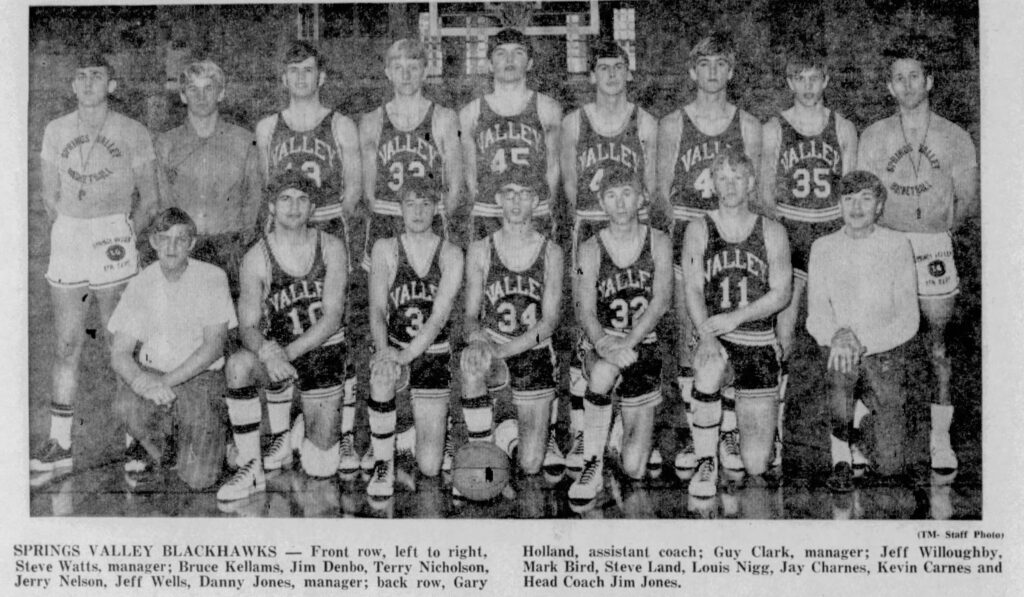
Sophomore Steve Land had plenty to do with Springs Valley’s success that year. Already standing at six four and close to two hundred pounds, Land had great moves under the basket and could rebound with anyone. In several games that season, Land was the high scorer for the Blackhawks. In the first sectional battle, a close 71-69 victory over Leavenworth, Land hit 9-11 shots and helped lead his team to victory with 19 points.
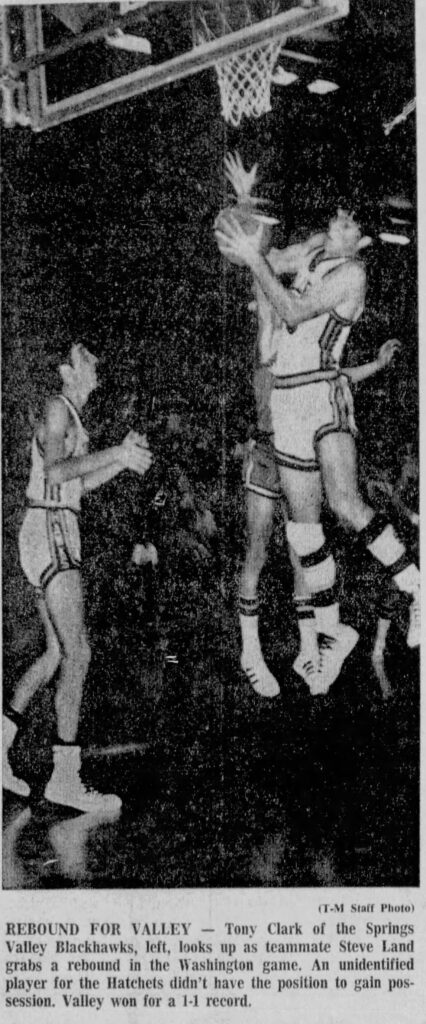
The final sectional game that year at Paoli is of special note to anyone interested in Indiana high school basketball lore. In the championship game against Milltown, Mark Bird made the winning foul shots, an event Larry Bird later explained inspired him to try to be a better player so that he too might be a high school basketball hero someday. Steve Land, meanwhile, ended the 1970-1971 year with a 13.7 scoring average, behind Mark Bird’s 17.8 and Kevin Carnes’ 15.6 averages.
That summer Land grew another inch and put on more muscle, weighing 205 pounds. He was a so-called wide body basketball player who still maintained his hand and feet quickness.
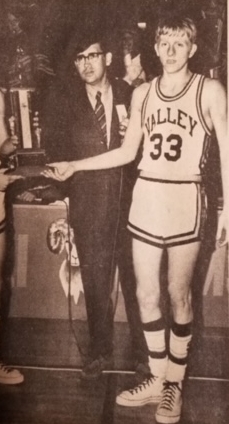
But the next year was especially difficult for both Land and the Blackhawks. Being the only returning player with much varsity experience, Land seemed to carry the Blackhawks on his back and the team came into the sectional with only seven wins. On the bright side, Steve emerged as a scoring and rebounding machine that season, leading Valley in scoring by hitting an average of 19 points a game and easily ending up as the team’s top rebounder. In the Blue Chip Conference that year, Steve also led the league in both scoring and rebounding, setting a single game rebounding record in the process. And yet again, one of the sectional games Steve played that year would enter Larry Bird lore.
Valley’s first match at the 1972 sectional was against West Washington, a team the Blackhawks lost to in the regular season by only three points. When the contest started, sophomore Larry Bird, at 6-1 and weighing 135 pounds, was riding the bench, having yet to play in a varsity game. Valley had built up a solid lead by the end of the first quarter, 22-11 and by twenty points in the second half before West Washington made a run and pulled to within 36-23 at halftime.
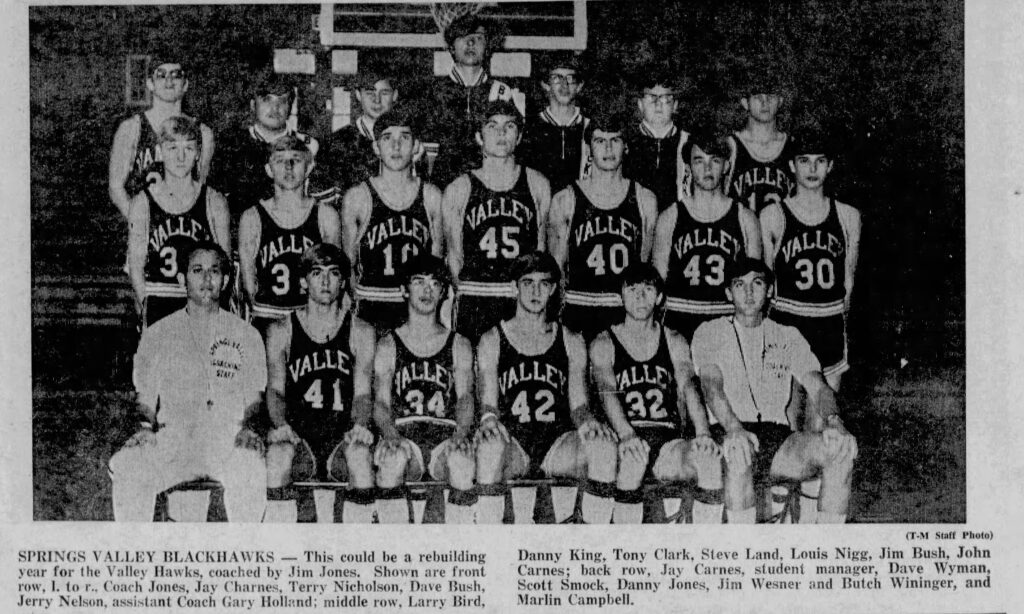
When the second half started, West Washington exploded, hitting shots and grabbing rebounds, taking a two-point third quarter lead and shaking the Blackhawks and their fans to the core. The fourth quarter continued to be a nail-biter, the lead swinging back and forth several times, the fans out of their seats, screaming in support of their teams.
At some point during the nip-and-tuck battle, Larry, unexpectedly, heard his name being called and did not realize for a moment that it was Coach Jones telling him to check into the game. “My heart,” Larry later said, “started pounding and I threw my warm-up jacket off and was at the scorer’s table before I knew it.”
It was not surprising Larry was so nervous. It was his first time in a varsity game, a contest of the highest stakes in the intense world of Indiana high school basketball. Up to the last few seconds of the contest, Steve Land had clearly been the hero of the game, finishing with a game high twenty-three points and piling up an astounding twenty-one rebounds. “Steve was just tremendous throughout the game,” observed one sports reporter.
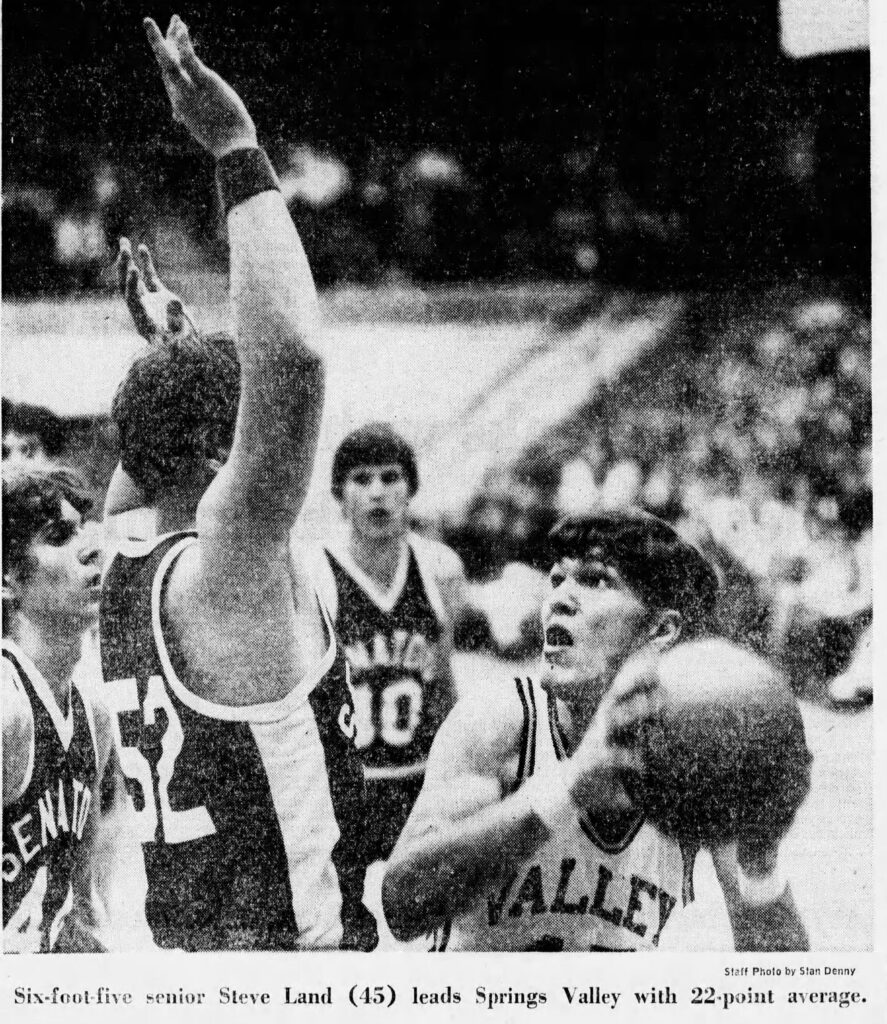
But then came the defining moment of the contest.
With a few seconds showing on the clock, Larry Bird was fouled, his team leading by a single point. Larry calmly knocked down both free throw attempts and Valley went up by three. A last second shot by West Washington ended the game with Valley on top, 58-57. Larry’s free-throws had made the difference.
The next day the Louisville Courier-Journal noted “Bird’s two free-throws were the clincher,” and headlined the article, Land and Bird Propel Springs Valley, 58-57. In the next sectional contest, Milltown beat Valley 70-59, knocking the Blackhawks out of the tournament. In that contest, big Steve Land notched 26 points for Springs Valley.
Coach Jim Jones, although typically a cautious man, all but gushed in an early interview about his upcoming 1972-1973 team, telling a Bedford paper news reporter, “We’ve got the biggest team we’ve ever had. We’ve got a lot of depth, and of the nine returning lettermen on the team, all started at one time or another.” The Blackhawks also had at least four good shooters, a rarity on most teams. The reporter certainly understood Jones’ situation, saying that “Optimism is oozing from the Blackhawk gymnasium,” and that the team was “loaded for bear.”
Jones had accomplished many things at Springs Valley—winning sectionals, going deep into state tournament play, developing several players who received college scholarships— but one accomplishment, a rare gem in Indiana high school basketball, had escaped his grasp, although it was not something he publicly made a big deal about. The rare gem was going undefeated in a regular season. Jones’ mentor, Rex Wells, had pulled off the trick his first year at Springs Valley in the late 1950s. Jones had always indicated, however, that regular season wins were not important to him, that these games were simply “a rehearsal for state tournament play.” A glance at the season schedule, however, suggested that almost every opponent was down to one degree or another except for Jasper and Loogootee. It had to be on the coach’s mind.
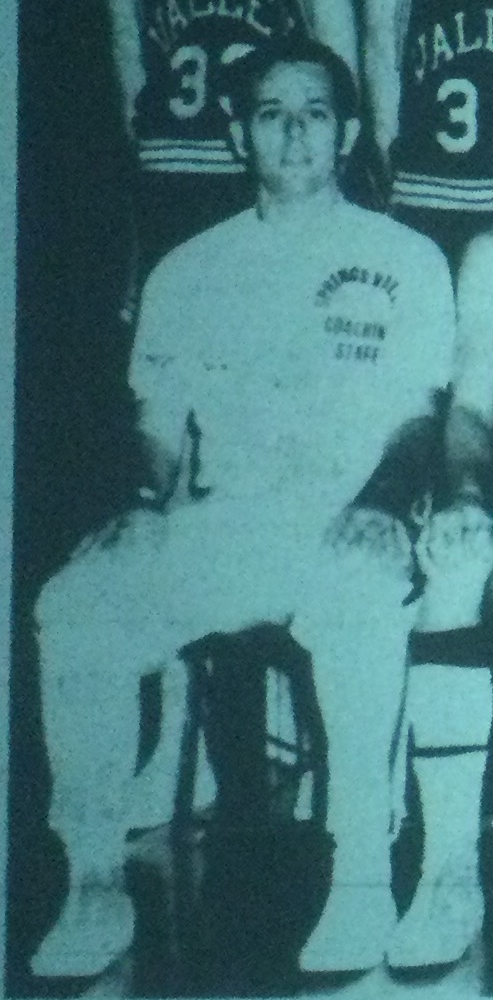
The first and second games of the season brought some reality to the possibility of winning every game. Pekin Eastern came to the Springs Valley gym with a 5-0 record and one of its best teams ever. The Blackhawks, however, got revenge from a loss the year before to Pekin, outscoring them in every quarter but one, and winning 77-60. The Bedford paper emphasized senior Steve Land’s essential part in the contest, noting that he “led all scorers with 26 points.” Larry Bird followed with twelve points and Tony Clark garnered eleven.
Valley’s second game, against the Washington Hatchets, took place at the spacious Washington gym. It was a hell of a nip and tuck battle. In the last stanza, Washington tied the score, then went ahead by four with 1:10 left in the contest. Then Land scored, followed by a stolen inbound pass by Danny King who then made another basket for Valley, sending the game into overtime. For the fifth time Steve Land won the opening tip as the overtime got underway. Steve went on to score four of the Blackhawks’ last eight points, leading his team to a thrilling 74-72 victory. Land and Bird would share the scoring honors, each getting sixteen.
Valley had little time to celebrate. They faced a tough undefeated Orleans crew next, a team that had come within a whisker of getting to the regional title game the season before and now had rugged Curt Gilstrap and feisty Mike McClintic back for another campaign.
Not to worry. The Blackhawks dismantled their county rival, a team that had thumped the Springs Valley squad 66-35 the year before. The solid victory caught the eye of the Louisville Courier-Journal which playfully headlined Land’s Sakes. Springs Valley bumps Orleans. Indeed, Steve Land was the big gun again, racking up 25 points.
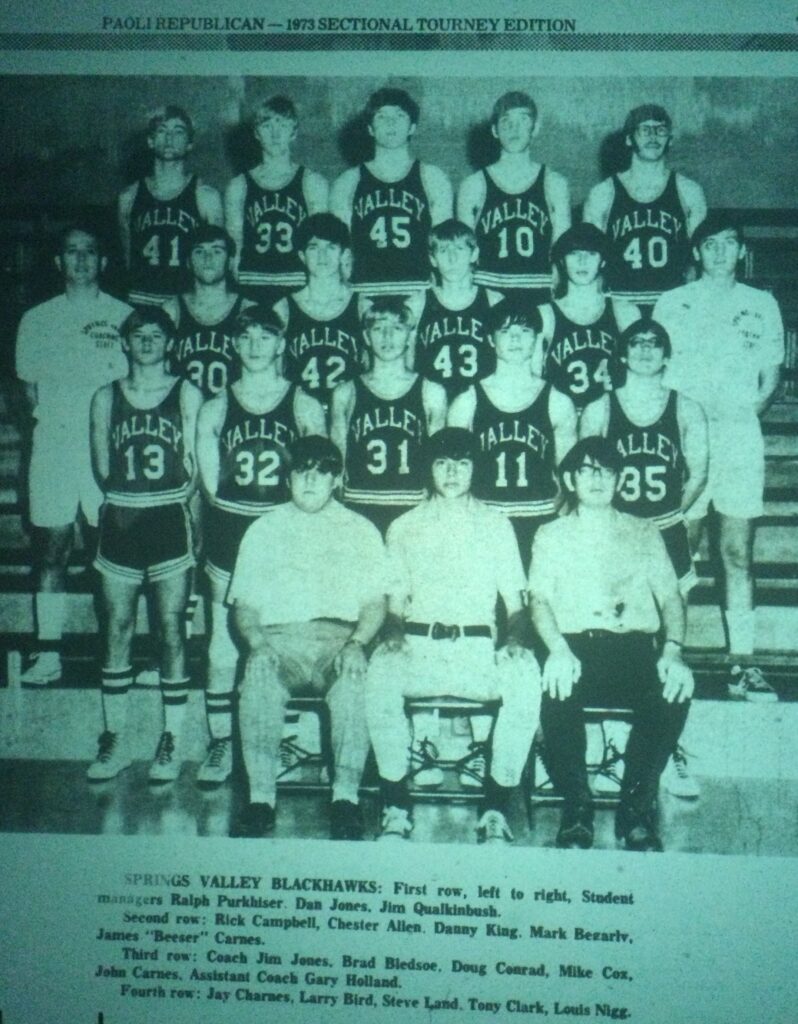
The Blackhawks had jumped a big hurdle in beating Orleans, but no one was thinking of an undefeated season yet.
The Blackhawks fourth contest was played at French Lick, with Valley taking apart North Daviess 67-48. The opposing team attempted to slow down the game and took an 11-9 first quarter lead before the roof caved in. James Carnes took scoring honors with 21 points, followed closely by Steve Land with twenty. Bird had six for the contest. Now the Blackhawks would be travelling to do battle with yet another undefeated team, their greatest rival, the Jasper Wildcats.
Jasper fans may have hoped that Coach Ed Schultheis gaining his 100th win the game prior to the Valley match-up would fire up the Jasper team. Instead of more glory for the Wildcats, however, a new basketball idol emerged from the shadows to take his place among the Blackhawk greats in the packed and deafening Jasper gymnasium that evening. The next day, Jasper Herald sports editor, Jerry Birge, called the “talented Steve Land” the hero of the game, the stocky Blackhawk dealing “the damaging blow at the start of the final eight minutes as he hit two from ten feet out and added two free throws for a 60-52 Hawk lead.” The game, however, was a nail-biter almost the entire way.
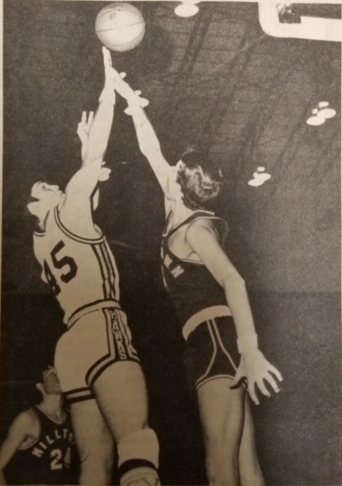
Jasper held on to its lead until the end of the third period, when Land hit a “thrilling” eight-footer as the horn sounded, giving his team a two-point advantage, and bringing Blackhawk fans to their feet. In the fourth period, Land won the tip from Mike Luegers, then scored when he got his hands on the ball. Steve then swiped a bad Jasper pass and scored again. Larry Bird grabbed another errant Wildcat pass and propelled a sharp and perfect pass to Land, who was then fouled in the act of shooting. Land cashed in both free throws.

Birge reported that In the final analysis Jones’ troops played “a near-perfect floor game,” committing only eight turnovers, shocking a strong Jasper team and winning 69-62. A reporter for the Louisville Courier Journal also wrote of the exciting Valley victory, headlining, Land spurs Springs Valley, and calling Steve Land “Valley’s top gun.” The Louisville piece also highlighted Land’s third quarter last second shot as the turning point of the contest. Perhaps the best eye witness was down on the playing floor. Jasper’s 6-8 Mike Luegers remembered Land that night as “being almost impossible to stop when he got the ball anywhere around the post. He had good hands, great footwork, and had one heck of a head fake. He was simply deadly around the ten-to-fifteen-foot range.”
Steve’s play now began to catch the attention of sports writers and college scouts. Harry Moore, at the Paoli Republican noted, for example, how Steve had led all scorers with 25 points in a particular game but added, “It’s hard to say if this was Land’s best game. It was score-wise, but in the Jasper game he looked great.”
Undefeated Valley’s next contest was against a red-hot Barr Reeve club that stood 7-0 and had won an astounding twenty-six straight regular season games. Many thought too that the Blackhawks would be ripe for a loss, the Barr Reeve contest coming so soon after the hard-fought victory over Jasper. But Coach Jones, one who typically never overstated his team’s potential, confidently told an Evansville Courier reporter before the game, “This is as good or maybe a little better shooting club than I ever had.”
Barr Reeve was the fourth team Valley knocked from the unbeaten ranks, and although the final score was 72-69 in favor of Springs Valley, the game was not actually that close. The scoring for the Blackhawks was evenly divided among three players who each got sixteen points, and another gaining fourteen. Larry tallied only six points, but Harry Moore pointed out that Bird still “played a whale of a game on the boards and on defense, making several steals.” Moore went on to praise the entire team. “Hard work has molded this year’s edition of the Hawks into a fine team. All last summer the boys were hard at it, and it has paid off handsomely.”
One underrated difficulty a really strong team faces during a season concerns playing much weaker teams. It is difficult to get up for such games and extremely embarrassing if an upset does occur. Further, nothing much is learned when the level of competition is missing. In general, these contests tend to be dull events, despite an often high scoring win total. This was the case in Springs Valley’s next several games. A review of the score book stats shows the dramatic situation. When playing in their first six games against solid teams, contests that helped the Blackhawks develop into a strong dynamic squad, Valley won by an average of only ten points. But in the next five games the Blackhawks played, they won by an incredible 48.6-point average, with the starting players being replaced early on by bench players. In these instances, the sharpness of the starting five could only be dulled.
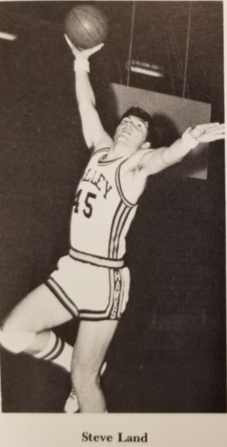
After easily winning their own holiday tournament, Valley played North Knox. The contest was a runaway for the Blackhawks, a game they would easily win 97-59. At some point in the game, after Steve Land had made almost all his attempts in the first half, someone realized Land was very close to breaking the old single game scoring record. It was a record shared by Land’s cousin, Jack Belcher, and by Marvin Pruett who had both scored 37 points in a game. The Valley players, especially Larry Bird, fed Steve the ball until he got the record.
The next day, the Springs Valley Herald reported, “Steve kept pouring them in from everywhere on the court.” Yet another reporter described how “Steve was outstanding in this game. His buckets weren’t gimmies. He worked for them. He got several tip-ins and several from 10 to 15 out. He hit 18-29 attempts and was five-for-five at the line. During the first half Land hit nine of 11 shots.” The Bedford Times Mail captured the importance of Steve’s play to the team when it carried the playful sports page headline after the North Knox contest, Hawks Are Going By Land.
After the North Knox victory, the Springs Valley team and community received a great surprise; the Blackhawks had broken into the state top-twenty basketball rankings in the single class arrangement of that day, holding the number seventeen position, the only school in that part of the state on the list. The team celebrated the ranking by going out the next game and steamrolling West Washington, 95-70. Springs Valley was now 11-0 and state ranked for the first time.

Perhaps Coach Jones thought he was lucky playing a down 5-7 Corydon team in the next game, a squad still tough enough to challenge the Blackhawks to bear down, and, in the process, get them ready for upcoming Loogootee. The Springs Valley Herald reported just before the contest, “Corydon has been an in-and-out team this year.” When the Panthers played the Blackhawks, they were certainly in. Corydon blew ahead 21-8 at the end of the first quarter and the Blackhawks were never in the contest, losing by 80-64 and getting out-rebounded 36-27. Worst, the Valley team made 18 turnovers.
Gone was the exciting hope for an undefeated season.
Oddly, after Valley’s unexpected loss, a Terre Haute paper, the Star, carried a detailed article about Valley’s and Steve Land’s super accomplishments in the Blue Chip Conference, pointing out how Land was “way in front in the hoop scoring race with a 25.7 per game average” and how the Valley team had set a new record for field goals in a game and for the most points made in a single game. The Vincennes Sun summed the latter successes up by headlining, Springs Valley Erasing Blue Chip Conference Records.

Fortunately, in the next contest, the Blackhawks got their act together and defeated county rival Paoli, then traveled north to play conference rival Loogootee.
Valley/Loogootee meetings on the basketball floor were always exciting, nerve-racking events, the primary competition between the two schools usually involving the Blue-Chip Conference championship, a prize for which the two schools often battled. The 1973 version took place on a Tuesday night in late January, played in a completely packed Loogootee High School gym, the crowd rowdy with excitement. The battle would leave every coach, player, and fan in a heap of exhaustion.
Larry Bird was on fire the first two quarters, scoring sixteen points, keeping Valley within a single point of Loogootee at halftime. Steve Land was having a good night too in the first half, plowing his way under the basket to tally eight hard earned points.
Interestingly, Loogootee junior forward Wayne Flick remembered little about Larry Bird’s play that night and a lot about Steve Land’s, especially a key play occurring just a few seconds before halftime. “Steve Land was a handful. Maybe 6-4 and 220. He’d just grind away, scoring and rebounding. We were having trouble shutting him down in the first half.” At the time of the key play, the Lions were up by one and were bringing the ball down the court with just a few seconds on the clock before the first half ended. Suddenly, Land stole the ball at half court and went down for what looked to be an easy layup. It would have been a basket that could have easily changed the momentum of the game.
Wayne Flick got there just as Land was going up to shoot. “I knew I had a foul to give so I made sure he didn’t score. It was a pretty rough block, one where today I would have probably been thrown out of the game. Steve had to be restrained but finally settled down. He missed both foul shots with no time showing on the clock to end the first half.”
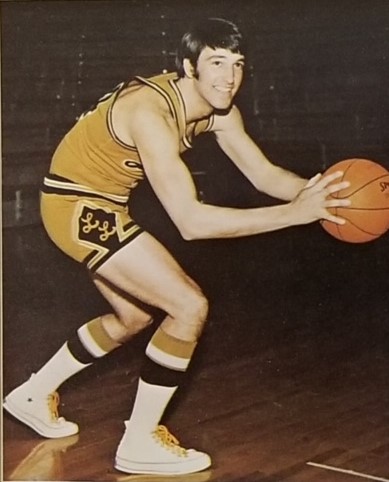
In the end, Loogootee prevailed, a last second Valley shot, in the words of Russ Brown, sportswriter for the Courier Journal, spinning “in and out of the basket, then hanging tantalizingly on the back of the rim for a couple of seconds—while the crowd oohed and aahed—before finally rolling off into the hands of Loogootee’s Bill Butcher as time expired.” Brown came into the Valley locker room after the game. “Coach Jones talked to him some,” Steve Land remembered, “but I was so disappointed, I had nothing to say.” The other players felt likewise.
Valley won their next six games going into the sectional tournament, and Steve Land was about to achieve another milestone. South Knox, a solid team, ran into an awesome offensive attack when they came to the Springs Valley gym the next game. In the first period, Steve Land had eight straight points before South Knox knew what had hit them. After Steve’s fourth field goal, the game horn suddenly sounded, halting the contest, and it was announced that Land had broken the Springs Valley all-time scoring record set by Marvin Pruitt. Coach Jones came out on the floor and presented Steve with the game ball and the crowd gave the Blackhawk hero a rousing standing ovation. Then the game proceeded as the Valley squad smashed South Knox 88-66. Land celebrated his major new record by leading all scorers with 22 points.
It should have been a record that would have kept his name on the lips of Valley basketball fans for years to come.

The Blackhawks won their remaining regular season games. Looking back, it was easy to see that the season had been a time of living in rare air, a Hoosier high school fairy tale. The team achieved the second best record in the school’s history, 18-2. The record was also Jim Jones’ best at Valley in his thirteen years of coaching there. Only the 1958 undefeated Springs Valley team surpassed the 1973 squad in wins.
Strangely, it did not feel like enough. The Valley tradition, set by the undefeated club back in the 1950s, was a heavy shadow to play under. The 1972-1973 squad now felt the pressure of going deep into the state tournament, or at least making it to the regional level. Jim Jones probably carried his own angst. When Valley was moved from the Huntingburg sectional to Paoli in 1970, Jones had told sports reporter Jerry Birge that the Blackhawks would dominate the Paoli sectional. But in the ensuing three years, Jones teams had won only one trophy prize at Paoli, and that was in the two squeakers where Mark Bird had stepped forward as the hero. Jones’ 1973 edition, however, was a powerful, well balanced group, the best all-around group he had ever had. It would be a devastating event if they did not at least win the sectional title.

Blackhawks fans could take comfort in the many sports writers in the region who picked the Blackhawks to easily blow through the completion at Paoli. Evansville Press writer John Updike announced that at Paoli, “Springs Valley can’t be touched.” Jerry Birge at the Jasper Herald wrote the winner at Paoli would be “Jim Jones and his Blackhawks,” while another regional newspaper declared, “Springs Valley in a big way.” The Evansville Press was already looking ahead to the Washington regional, where they picked Jasper and Springs Valley as having the best chances of winning the title there. This newspaper article also looked in depth at the Springs Valley squad. “This is a good team, a lot better than some northern posters figure, though the Blackhawks haven’t had much trouble convincing southern writers and coaches.” Calling Steve Land, “the major cog in the Hawks offense,” the piece went on to emphasis that Land was “capable of scoring 25 points any night and is the key to this team, one that can score upwards 80 or 90 points on any given night and can play with anyone.” The sports reporter added, after praising Land, “Tony Clark, Dan King, and company will just go out, do their job, and provide the balance necessary to win.” This latter observation was understated.
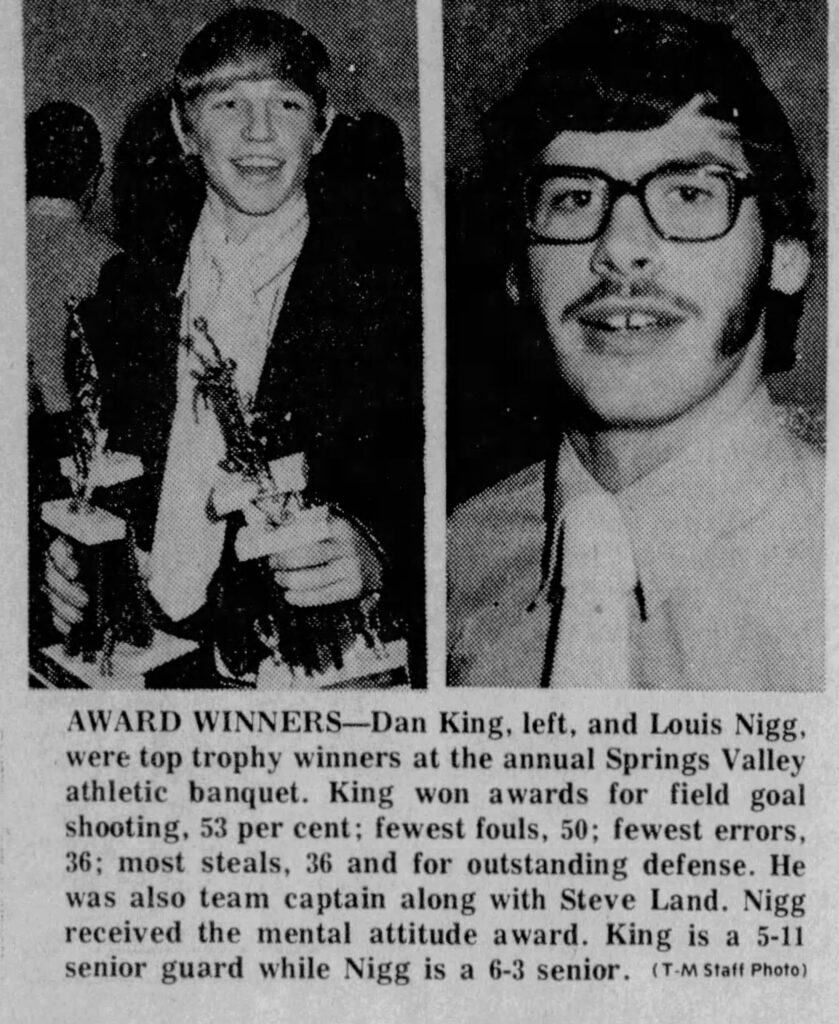
In truth, by the end of the regular season, the Valley team was now much more than just the superb Steve Land, having come together to play in dynamic fashion. All five starters had been leading scorers in the game at least twice. Also, Danny King had developed into the squad’s “floor general” and Larry Bird was scoring and rebounding at a solid rate while making passes that amazed the crowds.
Harry Moore at the Paoli Republican was the one sports writer who sounded an alarm. “If the Hawks aren’t careful, that 18-2 record can go right out the window, Practice is over; the big games are ready to commence. And in tournament play, it takes only one game.” But Moore conceded that “Coach Jones has had a lot of success in tourney play. This year’s edition seems to be what Coach Jones has been waiting for. Eight lettermen make up this year’s roster. Each one of the lettermen has been a starter.”
Many year later, Coach Jones noted in an interview that he was “sure we would win the sectional. I knew we were in good shape. We were ready.”
When the Valley bus carrying the Blackhawk players arrived at the Paoli gymnasium for their first game with Milltown, the players and the Valley fans were in for a disturbing surprise. Although the Blackhawks and the Rams would only play each other if both teams made it to the final game, some of the Paoli students had placed a large display in a glass case in the hallway to the gym that featured a huge paper Sesame Street Big Bird with Steve Land’s number on the front. Land thought it was funny, but his family was upset.
The game with Milltown, however, seemed only to electrify Jim Jones’ team. “The Hawks ran the Millers ‘out of the gym’ in a runaway victory,” reported the Bedford Times-Mail. Slender Tony Clark hit six of eight tries in the first half, but Dan King had captured the scoring honors with eighteen when the final horn sounded. Land was second in scoring with fourteen points, followed by Clark with thirteen and Bird with nine. Of the twelve Valley players, only two did not score. Valley ended up winning 78-47, a thirty-one point spread. Even more important, the Blackhawks had shot an amazing sixty-three percent in the win.
Springs Valley was rolling now, possessing a shining 19-2 record. And they prepared to meet county rival Orleans with the knowledge they had soundly whipped the Bulldogs earlier in the season, 60-47. Valley fans figured they would be playing Paoli in the final game, and that this would likely be an easy victory, the Blackhawks having dominated the Rams earlier in the season. Excitement was running sky high in the Valley.

It was ironic that Orleans Coach Charles Denbo had grown up in West Baden, a part of the Springs Valley consolidation with French Lick, although few in southern Indiana during state tournament time probably thought much about abstract concepts such as irony. Denbo certainly saw things differently than Valley supporters before the Bulldogs’ semi-final sectional game with Valley. And with good reason. After losing three of their first eight games, the Bulldogs lost only one contest the rest of the regular season, and that loss involved a close 46-42 contest with powerhouse Loogootee. Assessing his team’s chances for the Louisville Courier Journal, Denbo argued, “We really don’t have any weaknesses that someone can get at. We play decent defense, our offense is good, everyone can score, we have pretty fair speed and quickness and we’ve done a good job on rebounding, despite the fact that we’re smaller by far than most of the teams we’ve played.” In their first sectional game against Marengo, the Bulldogs shot over fifty percent. Of course, it helped greatly that Orleans had one of the best big men around, rugged Curt Gilstrap. A junior, Curt had performed well his sophomore year and was on his way to breaking several Orleans scoring records. Coming into the sectional, he had a twenty-one point and a seventeen a game rebound average. Steve McCracken, a senior, scored at a seventeen point clip for the Bulldogs and junior Mike McClintic could quickly turn a game around with his clutch shooting and never-say-die attitude. Like the Blackhawks, the Bulldogs played hard nosed, disciplined basketball. They would be the last team you would want to have stacked up a big lead on you out of the gate.
It probably hurt the Blackhawks that they had few, if any, games in the regular season where they had to struggle back from a large deficit in order to win. As it turned out, the Blackhawks were staggered in the very first quarter after the Bulldogs took a 23-15 point lead. Orleans never looked back. They were never behind and were “in total control throughout the process,” explained the Courier-Journal the next day. Orleans could hardly miss, hitting at a fifty-six percent clip. Curt Gilstrap hit 11-19 baskets and was 8-8 from the foul line for 30 points. Valley, meanwhile, hit only thirty-six percent from the field. The box scores tell the story of Valley’s collapse in shooting accuracy. Larry Bird was 6-22, Land, 5-15, and Danny King, 6-16. Harry Moore at the Republican, pointed out that “The ball took crazy bounces for the Hawks and it was just the opposite for the Bulldogs. For them it took crazy bounces, but fell through the hoop.” The Bulldogs, according to Moore, also “played like a championship team. Coach Charles Denbo had them ready. They jumped out early and kept a big lead.” Moore, however, praised the game of Blackhawk Danny King. “Dan King played one whale of a game. He was all over the floor on defense and held Bulldog ace Steve McCracken to 11 points.” Moore also noted, “Curt Gilstrap was superb.”
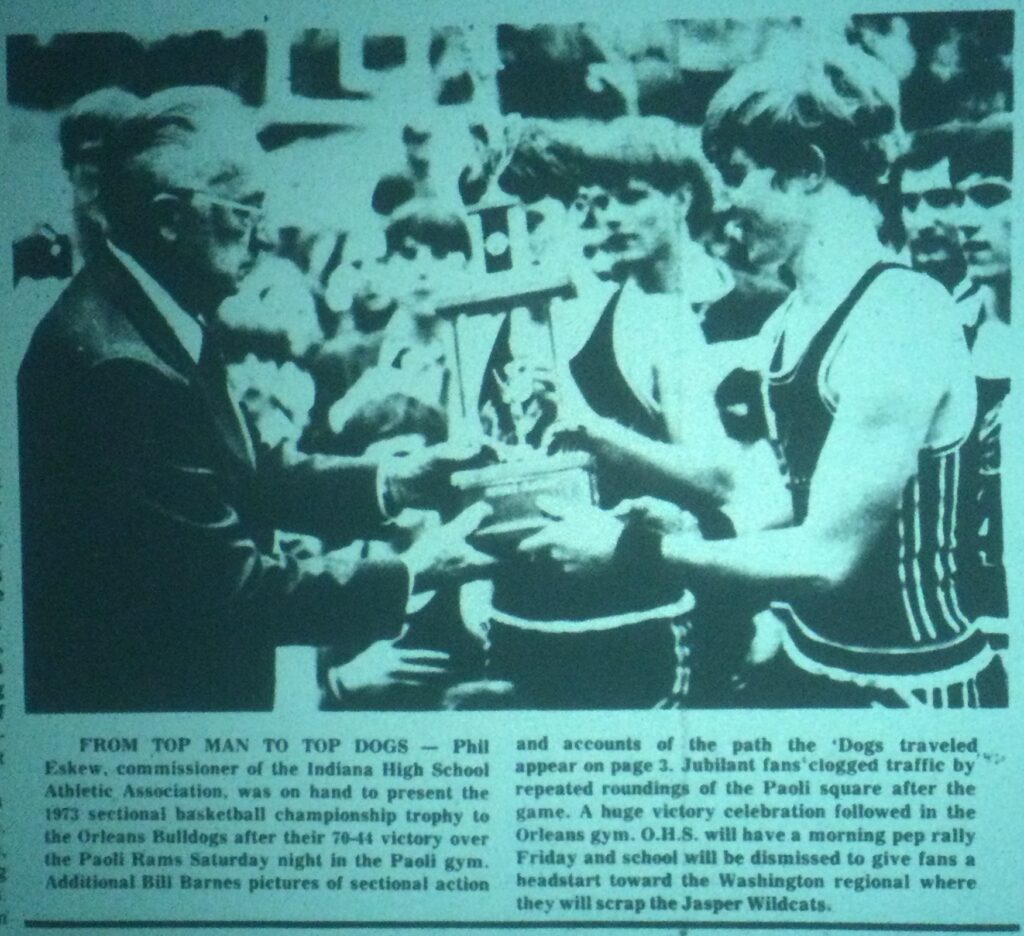
The 1972-1973 season’s end for Valley now seemed to verge on the tragic. The home town newspaper spoke of the game and its impact on the season as if they were speaking of a death. “This has been a long week for Hawk fans and players trying to relive the game and find out what went wrong. These boys gave everything they had but one night can ruin a good year for everyone. This has been a good year for Coach Jones and the Hawks, finishing with the second best record in Hawk history, but the big one got away.”
Coach Jim Jones was devastated. “I didn’t talk to anyone after the game,” Jones recalled.
This was the best Valley team Jones would ever have—balanced, skillful, and dynamic in play. Without a sectional victory, however, the sterling 18-2 record, the second best regular season record ever accomplished by a Springs Valley boys’ basketball team would be all but forgotten, never enshrined in the gym with a large team photo hanging on the wall, the teams’ hard work and great success cast into the dust bin of time. Also to be forgotten were the other great records, the scoring feats of Steve Land and of the Springs Valley team, and of Land and Bird making the all-conference first team.
If there was one winner to be found as the dust settled on the disheartening season, it was junior Larry Bird. By playing with a cast of awesome seniors—Steve Land, Danny King, Tony Clark—Bird had been able to play with less pressure, leaving him to develop at a more comfortable pace with his scoring, rebounding, and passing. If Bird had been carrying more of the load, especially as a 6-3 forward, the pressure might have had an adverse effect. Instead, he and the Blackhawk team received great support from the fans and sports writers, the kind of adoration that lifted Bird to play his best basketball. And since Bird had one more year left, the sense of a ruined season at the very end might not have touched him as deeply as it did Coach Jones and the seniors.
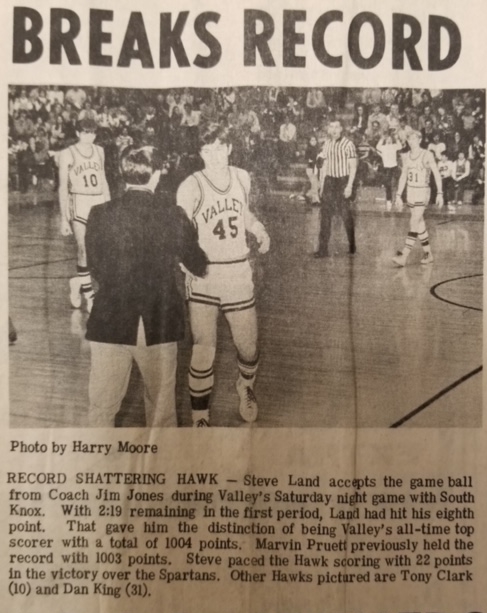
The saddest casualty of the unexpected and heartbreaking end to the season, Steve Land, spend the Saturday night Orleans played and beat Paoli for the 1973 sectional championship at the local French Lick Springs Theater. He sat slumped down near the back of the cavernous room, crying in the darkness, wondering how his team could lose only two games all year and not even be conference nor sectional champions. Steve could not have known that the next year Larry Bird as a senior, working with a lesser cast and playing in every game for all four quarters, would be completely unleashed, breaking all Steve Land’s astounding records and casting Land’s accomplishments to the wind.
The 1972-1973 year, once so full of promise, came to be the Blackhawks’ forgotten season, and the season of the forgotten Blackhawk, Steve Land.
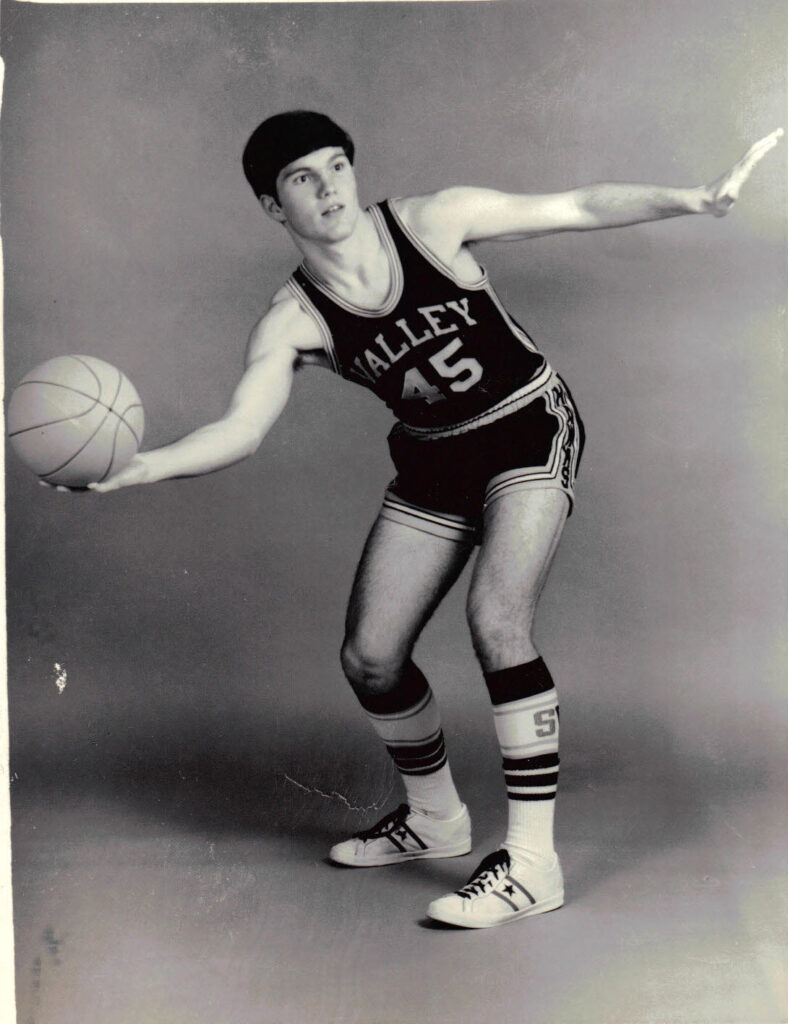
Land did not play college basketball, his parents being emphatic about education being his future, not athletics. Steve attended Indiana University and the school of medicine there and practiced medicine for nearly forty years. Steve also went on to do work in the area of confronting violence against women and children at the state and national level, eventually receiving a Sagamore of the Wabash award for this work, Indiana’s highest civic recognition.
But the story does not end here.
Thirty some years after the Blackhawk’s and Land’s devastating season, in 2004, Wayne Flick was patrolling in his state police car along US 31 north of Indianapolis when he clocked a late model Cadillac running well over the speed limit. “When I pulled the car over, I noticed the driver was wearing doctor scrubs and discovered he was coming off a late shift in the ER.” Flick, not in the best of moods, took the man’s registration and driver’s license and told the driver he would be right back.
What he read, as he began filling out a ticket form shocked him. “While going over his paperwork, I realized it was Steve Land! We had not seen each other in over thirty years, not since the night I knocked him down to stop him from making that lay up and we beat Valley in an extremely close game.”
Memories came flooding back as Flick walked to the Cadillac and gave the driver his registration and license. He handed Land a warning ticket, telling him, “I didn’t have the heart to write you a ticket. Now, we are even.”
When Steve discovered it was Wayne Flick, he got out of the car and the two men, once adversaries, hugged. Then they stood next to Flick’s squad car and talked for the longest time about 1970s basketball, smiling and sometimes laughing as the memories poured out, as if a dam had been broken. Traffic slowed down like moving water flowing around a rock, drivers and occupants gawking at the two men, wondering what a state trooper and the pulled over guy were so adamantly talking about. But Steve and Wayne were far away in another world, remembering a time, and a place, and a game now mostly forgotten, perhaps sadly knowing too that succeeding generations would never understand what they would never forget.
